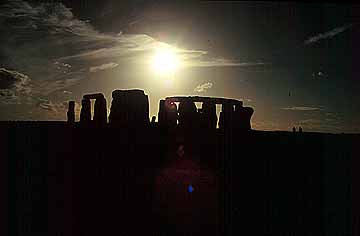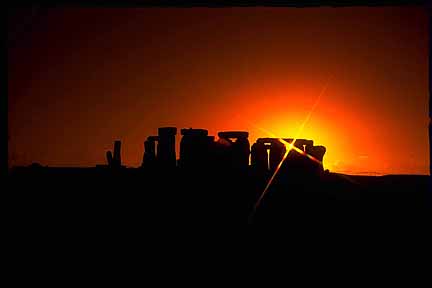by Dr. F. E. Tunalu, Ph. D.
As I. H. Longworth notes in "Prehistoric Britain" [LON1], at the end of the last Ice Age, the land
bridge between Britain and the Continent was severed by a great influx of water. "From this
time on," Longworth says, "Britain was to remain an island, often in contact with but never again forming
part of the European land mass."
Scholars agree that this is the origin of the Atlantean mythos - that the area now occupied by the English
Channel was the location of the pinnacle of pre-Romanized civilization in England. It is assumed
that the lost city of Atlantis is now lost to us, beneath the churning waters of the sea.
Atlantis was a partnership. A modern democracy formed by the neolithic inhabitants of Britain
in close cooperation with their benevolent overseers - visiting extra terrestrials from outer space.
These extra terrestrials are described by Pliny, Apuleius, Atheneius and other classical authors as
the mythical Hyperboreans.
According to the historian Jean Markale in his book "The Celts" [MAR1],
Mela's description certainly describes a second alien base which was located above the Arctic Circle. This
is especially revealing as containing an underlying truth as no ancient Romans are known to have visited this region.
Markule goes on to conjecture that the Hyperborean myth originated from the neolithic culture of Britain,
which was expelled by the Celts, later to return as the "Cimbri." It is my belief that among the many fantastic
qualities attributed to the Hyperboreans was one that they shared with their neolithic partners: the knowledge
for constructing powerful supercomputers out of ordinary materials such as stone and wood.
The most famous of these antediluvian mainframes is of course the Hyperborean Monolith,
Stonehenge.
But Stonehenge was one among many monolithic computing devices which were networked together
across the isle of Britain and no doubt connected to much more advanced devices at the
Hyperborean base at the north pole. It is assumed that the majority of these supercomputers
were in Atlantis itself, and were lost to antiquity when the waters suddenly came in - destroying years
of advanced culture and inspiring world-wide myths of a "great flood."
The flood also triggered the exodus of the ancient alien masters, for reasons unknown to us. Certainly
they were not finished with their great task - but why did they leave and never come back? Were they
allergic to water? Were they driven away by invading Barbarians? Or were they simply tired and frustrated,
after seeing so many centuries of work destroyed. Only history can tell.
The alien exodus left the native neolithic culture in a shambles. Most of these stone or bronze-age men and
women were ill equipped to handle the demands of a large and advanced computing system. As a result, the large
monoliths gradually shut down, or crashed, never to be rebooted, until centuries later,
with the influx of the Celts.
The Celts had an advanced agricultural culture, and quickly displaced or assumed the identify of the more
primitive neolithic culture over most of the Isle of Britain. It is assumed that the early Celts were very
warlike, and consumed the bodies of their victims.
It is not known when the first Celt discovered the long dormant 'secret' of Stonehenge, but radio-carbon
time-stamping indicates that this knowledge, once discovered, was very quickly absorbed and utilized
by the Celts. The Druids were not, as popularly supposed, a religious sect. They were the first
Celtic computing culture.
The established fact that the Druids reverered
Stonehenge as the holiest of places, even though they did not build it, indicates their deep understanding
of it's technological signficance. The Druids are to be commended for avoiding the "not
invented here" attitude so often employed by modern day software engineers.
The Druids wisely kept their knowledge of computing arcana a great secret from those outside the cult.
This was not the first, but perhaps the most telling use of the notion of "job security." As a result,
the Druids gained great power and influence over their more ignorant and superstitious brethren.
The downfall of the Druids' great power and dominance was clearly signaled by the invasion of
Julius Caesar, and came to fruition very quickly after the invasion of Claudius, a few decades
later.
Technological problems were immediately apparent, as the Druidic computers will ill equiped to
handle the conversion to Roman numerals. Even more problematic was the change in dates from
1 BC to 1 AD, which caused many systems to crash irrecoverably. But technological problems usually
have simple technological fixes. The biggest problem was not an engineering problem - it was
a deep and knotty social problem:
Unfortunately, the Romans, although superior builders and warriors, had no appreciation for computers.
It is believed that the excellent weather in Rome caused a natural inclination for outdoor activities
and exercise, all known to be bad influences on the production of software.
Although the Druids had the significant advantage of terribly bad weather, it was their extreme secrecy,
long a significant advantage for their cultural dominance among the Celts, that ironically led to the complete utter and devastating loss of all
computing knowledge in the Western Hemisphere. To put it quite simply, the
Druids had no desire to share their secrets with their future masters, the Romans, and the Romans
had no desire to receive this information. The result - a complete and utter blackout of information
that lasted for nearly two millenia.
It is only now that the great secrets uncovered by the Druids are again being discovered by the
Institute for Druidic Technology. For years, important archaeological finds have been erroneously cateloged,
due to the ignorance of "old school" archaeologists, who as a group, tend to be woefully computer
illiterate. Of course, it doesn't help that most ancient computers were so advanced in their technology
that they had no moving parts, thus eluding identification as machines, rather than the rudimentary
output of prehistoric quarrymen.
F. E. Tunalu, IDT Institute, Spring, 1997
Photography by Cliff Wassmann
I. Origins
Diodorus Sicilus includes Britain
among the Hyperborean islands and says that the soil produces two harvests a year there. He also describes
it as the birth place of Leto, which explains why the islanders particularly revere Apollo, her son, and
mentions a huge, round temple, presumably Stonehenge... Pomponius Mela mentions the six-month-long
days and nights and adds "...a sacred land, their country is open to the sun and extremely fertile."
[the italics are mine]

II. The Celts
II. The Demise
